Composition
RELATIVE POPULATION OF THE CONSTITUENT UNITS
At the time of Independence in 1947, India was partitioned into two separate units, Pakistan and Indian Union. About 23 percent of the area and 18 percent of the population of India in 1941 was transferred to Pakistan. The latter state split again in 1971, with the eastern component forming the new state of Bangladesh. In Table 2 below, we summarise the area and the population of the three units into which India got split.
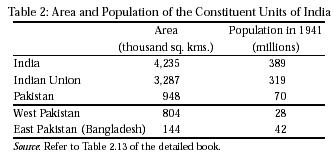
After Partition, the census organisations of the three units have carried out independent censuses and have also published the pre-Partition figures by disaggregating the data for the three units. Based on this information, we compile the population figures for the three constituent units of undivided India in Table 3 below.
The most remarkable aspect of the data in Table 3 is the distinct differential in the rate of growth of the population of the areas that constitute Indian Union as compared to that of the other two units, especially Pakistan. Thus in the 90 years between 1901 and 1991, population of Indian Union has multiplied by a factor of 3.55, while that of Bangladesh has multiplied by 4.23 and that of Pakistan by 6.72. Average compounded annual rate of growth of the population of Indian Union for these nine decades works out to be 1.418 as against 1.616 for Bangladesh and 2.140 for Pakistan. As a consequence, the share of Indian Union in the population of India has declined from 84 percent in 1901 to 78 percent in 1991.
This trend of the declining share of the population of the areas that constitute Indian Union
today is known to have persisted since at least the middle of the nineteenth century and seems likely to continue for the next several decades. The trend is reflected in Table 1 above, where we have noticed that the share of Indian Union in the population of the world in 1991 has not yet reached the level of 1850, while that of India as a whole has slightly surpassed the 1850 level.
This circumstance has been contributing considerably to the changing religious profile of the population of India, which we study in detail below.
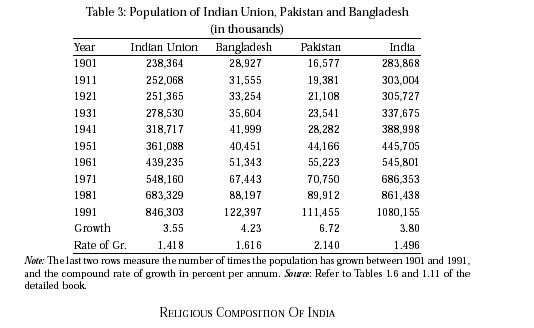
RELIGIOUS COMPOSITION OF INDIA
The changing religious profile of Indian population has had a strong impact on the recent history of India, and it continues to be amongst the major determinants of strife on the Indian subcontinent. Fortunately, unlike the caste and community affiliations, the religious affiliations of the people of India have always been recorded in the census operations. Therefore, it is possible to obtain a fairly rigorous picture of the changes in the relative populations of different religions for the period covered by the census operations.
Religious Composition of India in 1881: Historical Background
At the time of the first detailed census in 1881, the adherents of religions of native Indian origin constituted about 79 percent of the population, of which 95 percent were Hindus. Of the remaining about 21 percent of the population, that followed religions of alien origin, as many as 96 percent were Muslims. This religious heterogeneity of the Indian population and its division into mainly the Hindus and the Muslims was a demographic reflection of relatively recent events in Indian history.
Up to about 1200 AD, India showed remarkable religious and civilisational homogeneity. Notwithstanding the great geographical expanse of India and the linguistic and cultural specificities of people living in different regions, there prevailed an almost timeless consensus on fundamental civilisational principles. These basic principles of India, which found diverse expressions in sophisticated philosophical discourse as well as in lay beliefs and practices, are collectively known by the name of sanatana dharma, the timeless discipline that forms the core of all religious doctrines of Indian origin.
All those who entered India from outside soon accepted these basic civilisational principles. In fact, up to the coming of Darius of Persia in the sixth century BC and Alexander of Macedonia in the fourth century BC, there were few external incursions into India. This had partly to do with the peculiar geography of India. The Indian subcontinent enjoys remarkable isolation from rest of the world. The land frontier in the north is blocked by the high and wide wall of the Himalaya, which is impassable except at a few points in the northwest; the long seacoasts in the south are far away from any other major lands and have few natural harbours. The land enclosed within these impregnable frontiers is one of the richest in the world. It is therefore not surprising that Indians, living securely within their vast and fertile lands for millennia, without fear of external aggression or internal scarcity, developed into a homogenous civilisational area. This homogeneity was anchored in sanatana dharma. Indians, living in their splendid and rich isolation, were at peace with themselves, with nature and the world; the sanatana dharma enshrines, at its heart, a sense of deep respect for all aspects of creation.
The Macedonian forces that entered India from the northwest were not able to proceed far into India. The generals whom Alexander left behind to govern the small northwestern territories that came under Macedonian control were soon defeated. The invasion led to an intense political consolidation under a vast and powerful indigenous empire. This deterred any further incursions into India up to the beginning of second century BC. It was only after the decline of this great empire that the Indo-Greeks and Indo-Bactrians began obtaining a foothold in northwestern India. They, however, merged into the Indian civilisational milieu so well that the Indo-Greek king Milinda is remembered as a great Buddhist scholar, and another Greek general Heliodorus became a devout Bhagavata, follower of the vaishnava stream of sanatana dharma.
Apart from the Greeks, others who made incursions into India included the Shakas and Indo-Parthians, the Kushanas of probably Central Asian origin, and the Hunas. Most of them were convincingly defeated; those who succeeded in establishing significant kingdoms often became great adherents and defenders of the Indian civilisation. Kanishka, the greatest of the Kushana kings, established an empire that extended from central and western India to central Asia. He is also known to have been a devoted follower of Buddhism and to have convened the fourth Bauddha Sangha in Kashmir.
The Indo-Greeks, Indo-Bactrians, Indo-Parthians, Kushanas and others thus, instead of disrupting the cultural homogeneity of India, became the carriers of Indian civilisational values and principles far and wide. Vast areas, stretching from northwestern India through Afghanistan to Xinjiang in China, and much of central Asia beyond, became suffused with Indian cultural influence.
Starting from seventh century AD, India faced a new external incursion, this time by the adherents of Islam. Islam, as is known, arrived on the world-scene with great expansionary vigour. Prophet Mohammad was born in 570 AD. In a single decade, between 622 AD when he arrived at Madina to 632 AD when he died, he had consolidated Arabia into a powerful and unified political and religious unit. In another decade following his death, the Islamic Caliphs had expanded the boundaries of Muslim power to cover almost the whole of Byzantine and Sassanid territories, the two great powers of the time. Between 637 and 643 AD, Persia was conquered and the Islamic borders touched Afghanistan. Egypt fell in 640 AD. In 711 AD, Spain was conquered. Then southern France was annexed. Within one hundred years of the Prophet's death, Arabs became the rulers of a vast region encompassing most of southern Europe and northern Africa, and all of west and central Asia.
Islamic naval and land expeditions began exploratory incursions on Indian borders from as early as 636 AD. But Islam could obtain a foothold in India only in 713 AD, with the victory over Sind. India successfully resisted further spread of Islam into Indian territories for the next three centuries. From the beginning of eleventh century AD, India began facing rapacious Islamic invaders of Turkish origin. Mahmood Gazhni invaded India several times from 1000 to 1026 AD and annexed Punjab to his empire. The Ghur successors to the Ghazni Empire were finally able to extend Islamic conquest into the heart of India after defeating the valorous Prithvi Raj Chauhan in 1192.
Thus, in contrast to the easy conquest the Islamic forces had in many other parts of the world, it took them more than five centuries to break the defences of India. From 1192 to around the end of the seventeenth century, various Islamic dynasties, derived from the Turko-Afghans and later the Central Asian Mughals, ruled over large parts of India. These about five centuries of Islamic rule constitute the first period in the long and unbroken history of India, when India was ruled by a group that did not subscribe to the fundamental civilisational and religious principles of India.
Islamic rulers, even those who were relatively tolerant of the Indian beliefs and practices and did not attempt to forcibly propagate Islam, were committed to retaining a distinct Islamic identity and presence within the larger and otherwise homogenous civilisation of India. Unlike all those who came into India before them, the Islamic rulers, consciously and perhaps conscientiously, resisted acculturation into the timeless civilisational and religious milieu of India. This thus became the first source of heterogeneity in India, dividing the Indian population mainly into two distinct religious communities, Hindus and Muslims, as reflected in the 1881 census cited above. In time, this demographic heterogeneity led to the Partition of the country into Indian Union and two separate Islamic enclaves.
However, after more than five centuries of Islamic rule and at the pinnacle of Mughal domination during the first half of the seventeenth century, the proportion of Muslims in the population of India had reached no more than one sixth. This indeed is a measure of the resilience of Indian civilisational values, and the strength of commitment the people of India have in them. Emperor Jehangir, who ruled during 1605-1622, records in his memoirs, Tarikh-i-Salim-Shahi, that "for the whole population of Hindustan, it is notorious that five parts in six are composed of Hindus, the adorers of images, and the whole concern of trade and manufactures, weaving, and other industrious and lucrative pursuits, are entirely under the management of these classes. Were it, therefore, ever so much my desire to convert them to the true faith, it would be impossible, otherwise than through the incision of millions of people. Attached as they are to their religion, such as it is, they will be snared in the web of their own inventions: they cannot escape the retribution prepared for them; but the massacre of a whole people can never be any business of mine." Jehangir also records a conversation with his father, Emperor Akbar, who is said to have advised his son, "Besides are not five parts in six of mankind either Hindus or aliens to our faith; and were I to be governed by motives of the kind suggested in your inquiry, what alternative can I have but to put them all to death! I have thought it therefore my wisest plan to let these men alone."
Peninsular India, consisting of the southern Malayalam, Kannada, Tamil and Telugu regions, had largely escaped Islamic domination. Islamic incursions into this part of India in the early fourteenth century led to a powerful consolidation under the mighty Vijayanagara Empire that was emphatically committed to the defence of sanatana dharma. From about the middle of the seventeenth century, people all over India, under several charismatic leaders, began to rise in revolt against the Mughal rule in almost all parts of India. The Marathas under Samartha Ramdas and his great disciple Shivaji, the Jats under Gokula, and the Sikhs under Guru Gobind Singh, created powerful military organisations that shook the Mughal Empire. By the end of the century, the Empire had more or less collapsed, and indigenous rulers were in the process of establishing themselves everywhere in India. However, before this Indian resurgence could be fully consolidated, the British entered the scene, and the restoration of Indian rule was thus delayed by another couple of centuries.
The British were perhaps even more contemptuous of the fundamental civilisational and religious principles of India than the Turko-Afghans and Mughals. They, through their patronage and propagation of Christianity, introduced another source of religious heterogeneity in India. But more than the spread of Christianity, the British contributed to the increase of heterogeneity by systematically negating and suppressing the civilisational homogeneity of India. Thus, even though the growth of Christianity in India during the British rule was less than spectacular, the share of adherents of indigenous religions began to decline precipitously during this period. This decline has not been arrested yet.
Islam and Christianity are the only heterogeneous faiths present in India. Besides them, there is a sprinkling of Jews and Parsis in the Indian population. They came at different times to escape persecution in their homelands, and established small communities that remained secure for centuries in the generally tolerant milieu of India. As is well known, the Parsi religion was completely annihilated in its land of origin with the rise of Islam; the adherents of the faith could survive only in India. Jews acknowledge that while they were being persecuted in every part of the world, their small community in India never had to face any disability.
In 1881, after about a century of British rule, Christians were just beginning to make their presence felt in India and constituted about 0.7 percent of the population, but the proportion of Muslims had risen to about 20 percent from about 16 percent indicated at the pinnacle of Mughal rule. Rise in the proportion of Muslims during this period was probably even sharper because of two reasons. One, the figure of one-sixth mentioned in Tarikh-i-Salim-Shahi is for those parts of India that came under Mughal rule. The 1881 census covered many areas that were not under Mughal rule and thus had little Muslim presence. Two, by the middle of eighteenth century, when the British began to acquire control over large parts of India, the Mughal Empire had been in decline for several decades, and this would have put downward pressure on the share of Muslims.
In the period following 1881, rise in the proportion of Muslims and Christians becomes a continuous phenomenon that we explore in some detail below. The religious profiles of the three units into which India was partitioned at the time of Independence are quite different and have shown disparate changes over time. Therefore, we first present the data for the three units separately, before compiling the profile for the whole of India.
Religious Composition of Indian Union: 1901-1991
In Table 4 we have compiled the religion-wise population of Indian Union for the period 1901-1991. The Table is based on the census data for the Indian Union for the 1951-1991 period, and on the disaggregated population data worked out by the Census of Pakistan for the prePartition period of 1901-1941.
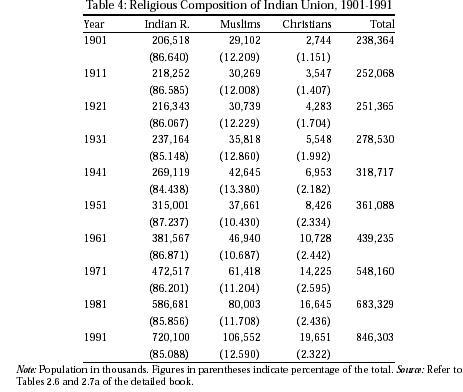
The Table indicates that the part of India that came to form Indian Union after Partition has a substantial majority of Indian Religionists; but their proportion has been declining throughout the twentieth century, except for the rise associated with the abnormal and traumatic event of Partition. In the pre-Partition period, the proportion of Indian Religionists in this part of India declined from 86.6 percent in 1901 to 84.4 percent in 1941. Between 1941 and 1951, their proportion rose by about 2.8 percentage points as a result of the forced and violent transfer of populations that occurred at the time of Partition. And in the following four decades the proportion of Indian Religionists in Indian Union has declined by the same 2.2 percentage points as in the four decades prior to Partition for which we have the data.
Consequently, there has been a net decline of 1.6 percentage points in the proportion of Indian Religionists in Indian Union between 1901 and 1991. This decline is not much larger only because of the intervening effects of Partition. Those effects have been almost completely wiped out by the continuing decline of the next four decades.
As far as the proportion of Indian Religionists in the population of Indian Union is concerned, therefore, Partition has proved to be a minor event in the long-term trend of a slow decline. And, as we shall see later, the growth of Muslims and Christians has not been uniform over the whole of Indian Union. It has been concentrated in various pockets; this has led to the formation of several clusters within Indian Union, where the proportion of Indian Religionists in the population is getting sharply eroded.
Religious Composition of Pakistan: 1901-1991
In Table 5 we have compiled religious composition of the population of those areas of India that form Pakistan today, largely on the basis of the religion-wise details provided by Census of Pakistan and the United Nations estimates of the total population.
The Table shows that Indian Religionists in this part of India formed a minority of about 15- 20 percent during the pre-Partition period. The relatively low presence of Indian Religionists in this part, as well as in the areas that form Bangladesh today, was of course the only reason for the Partition of India.
What is more significant about the data on the religious composition of Pakistan is the fact that the proportion of Indian Religionists in the population was rising considerably during the pre-Partition period; their share went up from 15.9 percent in 1901 to 19.7 percent in 1941. Correspondingly, the proportion of Muslims declined from 83.9 to 78.8 percent during the same period. This was in fact the only part of India, where Indian Religionists were growing at a rate higher than that of Muslims and were thus improving their share in the population.
This phenomenon, which became pronounced from 1921 onwards, had the potential of modulating the overwhelming Muslim majority of the region and making it part of the mainstream of India. However, Partition brought this possibility to a swift end. At Partition the region was purged almost clean of Indian Religionists. Their number came down from 5.57 million in 1941 to 0.65 million in 1951, and their proportion in the population declined from 19.7 percent to 1.6 percent; it has remained around that figure since then.
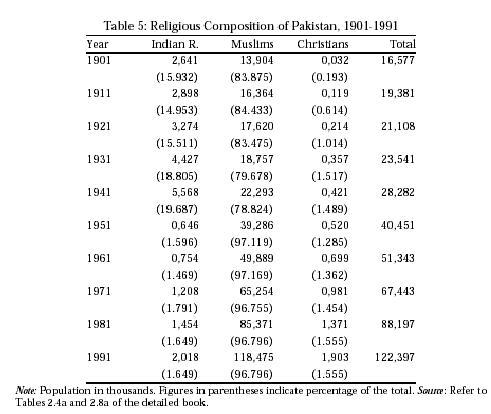
The few Indian Religionists remaining in Pakistan have continued to register a slightly higher rate of growth than that of Muslims even in the post-Partition period of 1951-1991. But their absolute numbers have remained insignificant. The effect of Partition on their numbers was so deleterious that, in spite of their relatively higher rate of growth in the pre-Partition and the post-Partition periods, their overall growth in the whole of this period put together turns out to be negative. The number of Indian Religionists in Pakistan in 1981, the last year for which enumerated census data is available, is about 55 percent of their number in 1901. Incidentally, the few Indian Religionists that remain in Pakistan are largely concentrated in the province of Sind. Census of Pakistan figures for 1981 show that of a total of 1.39 million Indian Religionists in Pakistan, as many as 1.27 million were in Sind. Also, more than 80 percent of all Indian Religionists in Pakistan were in the rural areas.
Christians in the region constituting Pakistan today have grown at a rate considerably higher than that of the Muslims in both the pre-Partition and post-Partition periods. At the time of Partition, Christians did not experience the kind of purge that Indian Religionists suffered. Consequently, they have increased their proportion in the population of Pakistan from about 0.2 percent in 1901 to almost 1.6 percent in 1981.
Of the three major religionists in the three constituent units, the effect of Partition has been the severest on the Indian Religionists in Pakistan. It seems as if Partition was designed to counter the growing presence of Indian Religionists in this region.
Religious Composition of Bangladesh: 1901-1991
In Table 6 we have compiled religious composition of the population of the areas that form Bangladesh today, largely on the basis of the religion-wise details provided by Census of Bangladesh.
The Table indicates that in the pre-Partition period, Indian Religionists had a much higher presence here as compared to the areas that form Pakistan today. However, their proportion in this region has been undergoing a persistent decline.
In 1901, Indian Religionists formed 33.9 percent of the population of Bangladesh; their proportion declined to 29.6 percent in the forty years from 1901 to 1941. Their proportion declined further to 22.9 percent in 1951 as a consequence of Partition; and in the forty years from 1951 to 1991, the proportion of Indian Religionists has been cut down to almost half, at 11.4 percent. Thus, in this 90 year period, proportion of Muslims in this region has increased from 66.1 to 88.3 percent, and that of Indian Religionists has declined from 33.9 to 11.4 percent.
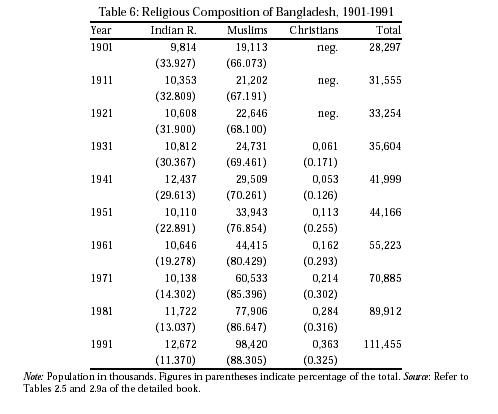
Thus, unlike in Pakistan, proportion of Indian Religionists in the region that constitutes Bangladesh has been declining continuously during the whole of the twentieth century. The region was not entirely purged of Indian Religionists at the time of Partition, as it happened in Pakistan. But a steady expulsion of Indian Religionists from the region has continued ever since.
Religious Composition of India: 1881-1991
Having discussed the religious composition of the three components units of India, we now compile religious composition of whole of India for the census period of 1881 to 1991 in Table 7 below. For easy reference, we have also compiled the religion-wise detailed population data of Indian Union, Pakistan, Bangladesh and India for the period 1881-1991 in Appendix Table I.
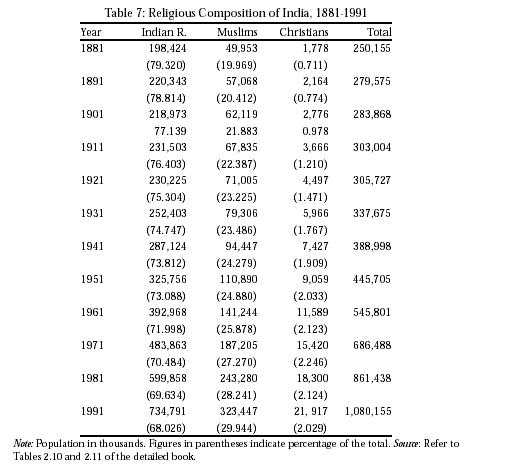
As seen in the Table, the proportion of Indian Religionists in the population of India has declined by 11 percentage points during the period of 110 years for which census information is available. Indian Religionists formed 79.32 percent of the population in 1881 and 68.03 percent in 1991. Correspondingly, the proportion of Muslims in India has increased by almost 10 percentage points, from about 20 percent to 30 percent. The proportion of Christians during the same period has risen from 0.7 percent to 2 percent. The decline in the share of Indian Religionists and the corresponding rise in that of Muslims has been a continuous process throughout the period, and the phenomenon does not seem to have abated yet. The proportion of Christians, however, seems to have reached a plateau after having risen continuously for 90 years between 1881 and 1971.
A decline of 11 percentage points in the share of the majority community in a compact geographical and civilisational region like India is an extraordinary occurrence to happen in the course of just about a century. At the peak of Mughal rule at the time of Akbar, after nearly four hundred years of Islamic domination, the proportion of Muslims in India was said to have reached no more than one-sixth of the population. As we shall see below, if the trend of decline seen during 1881-1991 continues, then the proportion of Indian Religionists in India is likely to fall below 50 percent early in the latter half of the twenty-first century.